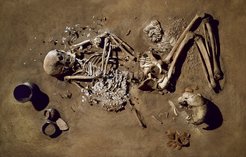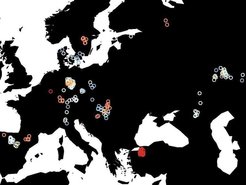8.000 Years of Adaptation in Europe Leave a Mark on Our Genes
Scientists provide evidence of a link between genetic changes and the spread of farming in the Stone Age
The invention of agriculture ranks as a revolution in human history. Arable and livestock farming spread across central Europe around 7,500 years ago. In the course of the associated developments, humans had to adapt to new environmental conditions, an altered food supply, as well as close contact with domesticated animals and their pathogens. The genetic selection processes that led to adaptation to this altered lifestyle are reflected in the genome of today’s Europeans. A team of researchers led by Wolfgang Haak and Johannes Krause from the Max Planck Institute for the Science of Human History has gained important new insights into this process.

The resulting study, which is currently published in Nature, is based on a database with a spatial and temporal scope which extends beyond those of previous studies. An international research team evaluated the genomes of 230 individuals from the period 6500 to 300 BC and compared them with corresponding comparative data from over 2,300 contemporary Europeans. “Our data set covers a period ranging from the late Stone Age, New Stone Age (Neolithic) and Bronze Age to the present day, and a geographical area extending from the European Steppe to Spain,” explains Johannes Krause, Director of the Max Planck Institute for the Science of Human History in Jena. The researchers were able to include the genomes of 26 Stone Age farmers from the west of today’s Turkey in their study for the first time. A direct comparison of the Anatolian and central European Stone Age farmers proved that they were closely related. This means that a spreading farming population was responsible for disseminating the knowledge about arable and livestock farming across large areas of Europe around 8,000 years ago.
Furthermore, it is also possible to trace specific characteristics with the help of the new data. According to these data, the gene mutation that enables adult humans to tolerate milk (lactase persistence), which is very common in Europe, occurred for the first time between 4,200 and 4,300 years ago and not shortly after the domestication of cows 8,000 years ago as had previously been assumed. Similarly, genetic variants which indicate an improvement in the supply of vitamin D and are particularly common in north European population groups today also emerged at that time. These variants are also linked with the lighter coloured skin of today’s Europeans which, due to its greater translucence, contributes to ensuring a better supply of vitamin D in less sunny regions: the Anatolian Stone Age farmers were already considerably lighter-skinned than the original European hunters and gatherers. Consequently, combined with the improved vitamin D supply and new way of life, the characteristic for lighter skin pigmentation was able to spread quickly in Europe.

Evidence of the adaptation to the more sedentary lifestyle of agrarian societies can also be found in other genes which play an important role in the immune system. “It was no great surprise to learn that with increasing population density and the spatial proximity to domesticated animals (e.g. sheep, goats, cows, pigs etc.), these genes were under considerable selection pressure and would have an important role to play. However, it was possible to demonstrate this directly for the first time,” adds Wolfgang Haak, a research group leader at the Max Planck Institute for the Science of Human History and one of the three main authors of the study.
Far more surprising was the discovery of certain genes that determine certain phenotypical characteristics, i.e. external physical traits, for example the EDAR gene which is found exclusively in Asian and indigenous American people today and is associated with thick hair, an elevated number of sweat glands, and a particular shape of the teeth and female breasts. This pattern was also detected in a 7000-year-old hunter-gatherer group from Sweden, a discovery that raises questions about the origin, spread and manifestation of these characteristics.
The study also reveals that our ancestors’ height, the outcome of the complex interaction of genetic variations, was also influenced by selection. Two contrasting developments emerged here. Compared to the height of the Anatolian Stone Age farmers, that of the Iberian Stone Age farmers clearly decreased over a period of 3,000 to 4,000 years. Meanwhile, the populations of the Steppe also became taller. It is assumed that the north-south divide that prevails in relation to height today goes back to these contrasting trends and this would also indicate that the populations of the Steppe mixed more extensively with the population of northern Europe than with the rest of Europe.

